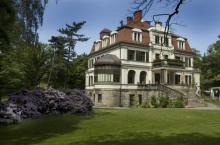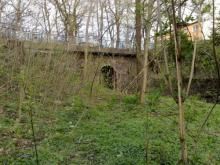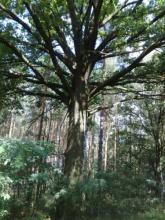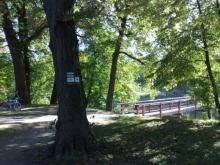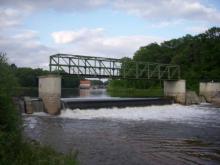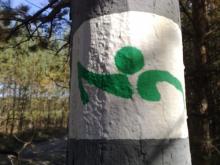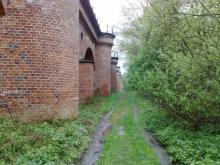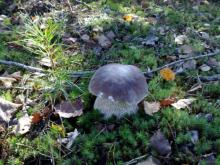Lubusz Nordic Walking Trails – Ducal Parks and Gardens – Żagań and the surroundings
"Ducal" Trail
The upper and lower park in the area of former borders of the area belonging to the palace, runs along the watershed of Bóbr River and the canal. The palace park is characterized by the diversity of tree stand, in particular plane trees, red beeches, Canadian Christmas tree, Wejmutka pine, black pine, tulip tree and European Christmas tree. On the route there a building of the former hospital founded by Dorota, Duchess of Żagań, St. Cross Church and a neo-Gothic chapel for followers of all religions.
Trail color – blue
Trail length – 4 km
Route type – scenic and historical
Difficulty level – easy
The blue trail, which is 4 km long, leads around the Landscape Park. A place of extraordinary natural beauty, picturesque landscape, encouraging to rest and spend free time.
The pride of Żagań is a landscape park with the total area of 77.49 ha, through which the Bóbr River flows creating a picturesque landscape with the Ducal Palace, the Holy Cross Church and the Princess Dorothea Hospital in the background. Interesting species of trees grow there, and some of them are nature monuments. The most valuable specimens include ginkgo biloba, Liriodendrons, plane trees, thuyas, yews, scarlet, red and pyramidal beeches, elm trees, spruces, Canadian Christmas trees.
After taking over the Duchy of Żagań by Dorota de Talleyrand-Perigord, efforts were made to tidy up the local park and transform it into a magnificent landscape. The task was carried out by Friedrich Teichert. The work of Princess Dorothea of Courland was continued by her eldest son and successor, Napoleon Louis de Talleyrand-Perigord. Since 1866, by order of the Duke of Żagań, on Sundays, holidays and every Tuesday and Thursday in the park there was a water art show for the public. The heirs of Prince Napoleon Louis also spared no expense in maintaining the park.
The city park is divided into three parts:
The palace garden, also called the Flower Park, used as an ornamental garden.
The central park with the pheasantry located on the island. The flat terrain of the pheasantry was used to create viewing areas for recreation.
Along the high banks of the Tylny Bóbr, in the upper park, there are numerous viewing points.
The most beautiful part of the garden was generally considered to be the so-called Dutch Garden by the orangery on the Bóbr River, built by Piotr Biron, which no longer exists. It is also worth mentioning other objects in the park, which during the reign of Princess Dorothea of Courland, added to its splendor: fountains, sculptures, the statue of Diana, the Frog’s Well and the statue of Venere.
In 1848 a greenhouse was built to the east of the chateau, where 200 kinds and 450 species of plants were grown in the time of Princess Dorothea. Very little of the palace decor of that time has been preserved. Today we can only see: Porter’s House, Fishing House, Holy Cross Church and Hospital.
The legend of the “unfortunate miller”
At Żelazna Street, in Żagań, on the edge of park surrounding the Ducal Palace and on the Bóbr River, near the bridge leading to Moczyn, stands the "Młynówka" guest house. It is housed in a former granary, built of timbered walls in the middle of the 19th century. At that time so called upper mill stood nearby. There is a legend related to this mill. The sad tale should be a warning for parents who want to ruthlessly decide about the fate of their children.
It happened a very, very long time ago. The miller Brunon was a wealthy man. Almost all the local peasants and landowners used his mill. Brunon had one child – his daughter Marianne. The beautiful miller’s daughter had a fair dowry, so her father hoped that his future son-in-law would be equally wealthy. However, the girl did not think about marriage for a long time, rejecting subsequent paternal candidates for her hand. Only a humble farmhand helping in the mill aroused feelings in her heart. Matthew was handsome, yet not that made Marianne take a closer look at the boy. The farmhand bravely committed an act which almost cost him his life.
On sunny summer days Marianne liked to stroll along the bank of a weir near the mill wheel. The falling water created cascades of sparkling drops, which reflected the light and formed miniature rainbows. On one occasion, the miller slipped on the dewy grass and fell into the river. She would have surely fallen under the mill wheel if it had not been for Matthew, who noticed what had happened. He rushed to the rescue, saved the girl, but was almost killed by the wheel. By doing so, he awakened the love of the miller’s daughter, to whom he had been secretly yearning for a long time.
The miller Brunon realized that something was going on between the two young people. He forbade his daughter to meet Matthew. He did not like the thought of such a son-in-law. He could reward the farmhand with money for saving the child, but there was no way to agree to the marriage. There was no other way out. Matthew had to leave the mill and with regret went to look for work somewhere else. In the meantime beautiful Marianne was wandering around the house like a ghost, standing at the window for hours watching sadly for her beloved’s return. The old miller was not moved by his daughter’s grief.
On a market day in September, the miller took Marianne to the market. Even the colourful goods of stallholders did not cheer the girl up. It was only when she saw Matthew in the crowd that her smile brightened up. The young couple sneaked out of the noisy crowd. They found a quiet corner in the shadow of the city wall and enjoyed their presence. The watchful Brunon found them quickly, chased the boy away, and took his daughter home. She was to sit in the mill until she wised up and chose a wealthy man to marry. The girl was adamant and preferred to die of hunger rather than marry without love. And so it happened.
Only the death of his only child made Brunon realize what a tyrant he had been. What was the use of his wealth now that he had no one to leave it to. He lost the drive to work, and the mill eventually fell into ruin. It was said that Brunon wanted to find Matthew and bring him into wedlock, but the boy was lost without a trace. When the old, bitter and sickly miller died, no one came to his funeral. The ruin was soon purchased by a new owner. Just a year later the mill wheel was spinning again near the Bóbr River, and the sound of working rushes signaled that new flour was being poured through the sieves and shakers.
The mill buildings no longer exist. Only a guesthouse reminds the old mill. The Żagans who live nearby say that on clear summer evenings, in the place where the weir used to be, sometimes an ethereal female figure appears. It is supposedly the unfortunate Marianne, who is still waiting for her beloved Matthew.
In the vicinity of "Młynówka" there is Żagań hydroelectric power station, a dam from 1900 and Louis Bridge – Napoleon-Louis, Duke de Valencay, the son and successor of Princess Dorothea of Courland.
Rhododendron Trail – Żagań – Iłowa – Żagań
Trail color – green
Trail length – 18 km
Difficulty level – medium, fast route
Trail type – scenic and cultural
The Żagań-Iłowa trail runs through an area rich in numerous tourist values. One of them is undoubtedly the Bóbr River with its tributaries: Czerna and Kwisa. We start the trail near the Museum of Prisoner-of-War Camps, then we go along the forest road in the direction of Żagańc, we reach Konin Żagański – the biggest village of the Iłowa commune, Iłowa is the destination of the trail.
We start our walk at the museum of Stalag VIII C and Oflag Luft 3. It is a very picturesque route in terms of nature running through the valley of the Czerna River. Dutch bridge, oak avenue, small hills and ferns like in the tropics, and on the way – amazing attractions for mushroom pickers. At the entrance to the asphalt road in Konin Żagański we are welcomed by a beautiful aged oak, we head towards Iłowa and a beautiful park in the Japanese style, where we are surrounded by rhododendrons, a bridge of love and a beautiful palace (now a school) – all this should be seen in order to properly perceive what nature has given us and what was wisely shaped by artists.
The Museum of Prisoners-of-War in Żagań is famous for an event which took place during the Second World War – the Great Escape from Stalag Luft 3, which was a complex of Nazi prisoner-of-war camps. This event has been the subject of many books and film adaptations. The film The Great Escape, starring Steve McQueen and Charles Bronson, was released in 1963, followed by The Great Escape II, starring Christopher Reeve, in 1988. Another successful escape from the camp was filmed by the British in 1950. The Museum of Prisoner-of-War Camps and the prisoner-of-war cemeteries are located on Lotników Alianckich Street. Every year there are celebrations commemorating this event. In 2009, the reconstruction of the Great Escape with the participation of international reconstruction groups was led by Bogusław Wołoszański. Hundreds of foreign guests, RAF soldiers, ambassadors and government representatives attend the anniversary of the Great Escape.
Żaganiec (before 1945 – Hermsdorf b. Sagan) – a village located in Lubusz Voivodeship, Żagań County, Iłowa Municipality, on the Czerna and Lubatka rivers, in the Żagań Forest (Bory Dolnośląskie). Through the village there runs the provincial road no. 296, which is the western border of the biggest military training ground in Poland – the Żagań-Świętoszów TSO. Below the mouth of the Lubatka River to the Czerna River there is a small hydroelectric power station with installed power of about 30 kW, which was renovated and put into use in 2009. In 1975-1998 the village administratively belonged to Zielona Góra Province. Population: 102 (data from 2010).
Konin Żagański – the biggest village of the Iłowa commune. It was founded around 1250 by peasants coming from Central German countries. While visiting Konin Żagański you should not miss the church of St. Bartłomiej, built in the Gothic style in 1505 on the initiative of the von Schellendorf family. From the Renaissance and baroque interior of the church the most valuable are fragments of the late Gothic triptych from 1506, chiseled by the Master from Gościszowice, restored tombstone of Christoph and Helena von Schellendorf and Renaissance tombstone of Heinrich von Schellendorf. Equally valuable monument is a bell cast in 1586, with a diameter of 119 cm. It is decorated with a beautiful image of the Virgin Mary. It should be remembered that at the beginning of the Second World War in Konin Żagański there was a dulag – a transit camp for several thousand Polish soldiers and non-commissioned officers. The camp was liquidated in April 1940.
Iłowa – was founded in the 10th century at the crossroads of trade routes leading from Żagań to Zgorzelec, Legnica and Gubin. At that time it was a forest settlement. Iłowa was granted city rights in 1679.
The Palace and Park complex was built in 1626 by Baron Christoph von Schellendorf. It was made a magnificent residence by Count Frederick von Promnitz, who undertook the reconstruction and extension of the existing building. After Frederick’s death in 1712, the heir became his yearling son Baltazar II, who took over the fatherland at the age of 25. After returning to Iłowa he renewed the deteriorating estate. He had no descendants and after his death the palace passed through the hands of different owners, who did not take care of it.
Luckily for the palace, in 1902 the estate was bought by the German Reich Count Friedrich von Hochberg. He decorated the palace with sculptures and bas-relief. He built terraces, planting them with extremely rare orchids and yews. He brought in many well-known and respected artists, taking care of his new residence. The Bavarian architect, Robert Klaus, built a second palace tower, used as an amateur astronomical observatory. The Italian artist Philippi decorated the rooms with stucco and panelling in the Baroque style. The park was gaining splendor, fountains were built, exotic plants were planted. Between the branches of the Czerna River there were small gazebos and bridges referring to the culture of distant Japan. The palace was no longer a landed residence and became a school building.
The park in Iłowa is one of the most beautiful gardens in Silesia, founded in the 17th century as a Renaissance garden by the manor. In the second half of the 18th century the park was enlarged and transformed into a landscape park. In 1901-1905 the park was expanded and, among others, a Japanese garden was created. Currently, the 20-hectare park is decorated with rich old trees with numerous natural monuments (oaks, beeches, lime trees, an alley of hornbeams), rhododendrons, and a Japanese-style garden.
The park viaduct over Garda Street in Iłowa, in the local tradition is called: "The Bridge of Love.” Probably in 1905, 50-year-old Friedrich Hochberg married young but poor, 19-year-old baroness Gizela von Salzbach-Gratz. According to local legend, the young countess cheated on her husband. It is likely that Friedrich caught his wife red-handed on this bridge and put her under arrest in the palace. When the young woman finally regained her freedom, she took advantage of her husband’s moment of inattention, stole the jewellery and some cash, and then disappeared. In 2008 a thorough renovation was carried out.
Żagań-Małomice-Żagań Trail
Trail color – red trail
Difficulty level – difficult
Route type – scenic and cultural
Trail length – about 30 km
It leads through the gorge of the Bóbr River, from Mały Bożnowo on the way you pass the remains of granges belonging to the Żagań palace. On the right side is one of the longest brick railway viaducts in Europe with 21 arched vaults. According to road and bridge builders it is a gem of a construction – still in use today – and on the route you pass the remains of the mill – beautiful beaches growing on the slope of the Bóbr bank up to Bukowina Bobrzańska. Further on Kammler’s Hill – the highest view point. After about 300 m you will see an amazing view – picturesque mouth of Kwisa River to Bóbr River. From Małomice to Rudawica and through Trzebów to Żagań we pass very interesting sacral buildings and landscape parks.
Princess Dorothea’s Post-Hospital Complex
The 19th century complex of St. Dorothea’s hospital consists of the Holy Cross church, the Loterian chapel, the main building of the hospital with the St. Dorothea’s chapel and several additional buildings constructed later, of which the so-called Maria’s House, located in Żelazna Street, stands out. The author of the hospital project was the court architect of Princess Dorothea of Żagań, Leonard Dorst Schatzberg. The building is maintained in the favorite style of the designer’s mistress, neo-Gothic.
The chapel is located in the building of St. Dorothea’s hospital. The cornerstone of the chapel was laid on May 3, 1851. In 1859 the construction was completed. Inside there is a beautiful wing altar from the end of the 15th century. The central scene shows the Coronation of Mary, on the sides: Annunciation, Visitation, Birth of Christ, Prayer of the Three Kings, in the predella – Death of Mary. On the altar cabinet stand, each of different origin, figures of the Saviour, Mary and the Christ’s beloved disciple. In the chapel there is also a statue of the Martyrdom of St. Dorothea and a picture of St. Hedwig in a nun’s dress.
Above the entrance, there is a bas-relief of Christ’s head. The chapel’s furnishings include benches and a chandelier in the neo-Gothic style. The entrance to the chapel consists of a door framed in flamboyant Gothic style. The finial features figures of two angels, between which there is a sculpture of the Virgin Mary.
The Holy Cross Church was founded by Duchess Dorothea Talleyrand in 1849. It was designed by Leonard Schatzberg using relics of a Gothic chapel. The interior with rich carpentry, sculpture and blacksmith furnishings has a uniform neo-Gothic character of great artistic value. The Catholic members of the duchess’s family found their final resting place in the church: Catherine Wilhelmina, Dorothea Talleyrand-Perigord and her son Louis Napoleon. Next to the church is the former St. Dorothea’s hospital.
Mały Bożnów. Within the Żagań municipality, probably on the order of Henryk Brodaty, the Żagań castellan or his successors in office carried out a colonization campaign. As a result of these actions, significant areas of primeval forest were settled east of the Bóbr River up to Kozuchów-Szprotawa. The action of developing the border forests falls on the 13th century. As a result of these actions new villages were created, including Bożnów, which is divided into two parts. Mały Bożnów is the ducal part from Żagań, where the farmhouse was located and changed its owners over the years. This part includes houses in the sand and also some houses in the south-western part by Żagań.
Moczyń. The Żagań settlement celebrating its 650th anniversary in 2006. The settlement has its own church and primary school. Certainly the most interesting building located in Moczyń is a brick railway bridge over the Czerna River, built in 1845-1846. It is one of the oldest buildings associated with the history of the Żagań railroad. Its construction started in May 1845, when the decision was made to join the Głogów-Zagań side railway line to the Lower Silesia-Marchy Iron Railway in Jankowa Żagańska. Nearby you can often hear the shooting of tanks because not far away, a few hundred meters from the buildings, there is a tank shooting range.
The Dutch Bridge – a wooden bridge constructed in 1997 by the Dutch sappers as a part of training conducted on the military training ground in Żagań.
Bukowina Bobrzańska is a village in Poland, located in Lubusz Voivodeship, Żagań County, in Żagań Municipality. In 1975-1998, the village administratively belonged to the Zielona Góra Province. Wi In the village there is the filial church of Our Lady of the Rosary. It gained the present neo-Gothic form as a result of a reconstruction carried out in 1856, when windows were rebuilt, gables were framed with bricks and towers and a porch were added. It is a stone, one-nave church with a rectangular presbytery, a sacristy and a chapel from the north. From the west, there is an octagonal tower of pole construction with walls narrowing towards the top and covered with slate. The interior decoration is neo-Gothic from 1856. The older equipment preserved include a Gothic altar (15th century), a sculpture of St. Anne (15th century) and a bell from 1469.
Małomice – Green Island in the Bory Dolnośląskie. The greater part of the commune of Małomice is located in Bory Dolnośląskie. It has natural borders in the form of watercourses, which are the rivers Bóbr, Kwisa and Ruda, and forest swamps.
The baroque church built in 1732 as an Evangelical church, founded by the then owners of the Małomice estate. After the Second World War it was partially devastated. It was renovated between 1982-1984 and became the seat of a newly established parish of Our Lady of Perpetual Help after being taken over by the Polish-Catholic Church. It is a baroque building, built of brick, set on an octagonal plan with a pentagonal apse on the west side and a circular staircase, partially built into the wall of the north-western wall. The interior is covered with a cupola with lantern. The facades are segmented with pilasters and hemispherical niches. The mansard roof with an octagonal lantern topped with a spherical cupola. Inside there are some stone tombstones, e.g. the Gothic one from 1414 and a number of Renaissance from the second half of 16th century with reliefs depicting knights of the Kotwicz and Milicz families.
The palace (now non-existing) was built at the end of the 17th century. It was modeled on the Lubkowice residence in Żagań. The palace was destroyed during the last war.
The regular garden – baroque in style – was certainly created by the above mentioned palace. Its existence today is confirmed mainly by iconographic sources.
The landscape park was created for a descendant of Fabian von Dohna-Schlodien (1802-1871). Its designer was Eduard Petzold, who worked on the park project from 1872 and then supervised its construction. The park is located in the northern part of the village.
The former farmhouse is located in today’s Tadeusz Kosciuszko Street. On its territory there are two farm buildings from the beginning of the 19th century. They are long one-storey buildings covered with hipped roofs.
Żelisław – village – the place where Kwisa joins the Bóbr River.
Rudawica – (German: Eisenberg) – church of the Assumption of the Blessed Virgin Mary, Gothic, built in the 14th century (first mentioned in 1376). It was expanded in the first half of the 16th century by extending the church building to the south and east as well as by adding a sacristy with an empora. Built of stone and brick, a hall church, closed on the eastern side with a tripartite window. The interior is covered with a cross and star vault supported on a column in the middle. This column enriches the space of hall separating it into two naves. Adjoining the church structure from the north is a sacristy with an empora, with a net vault. From the western side, on the axis of the 14th century foundation, there is a diagonal tower, made of brick, wooden in the upper part, topped with an onion-shaped shingle helmet. The interior decoration is late baroque. The late gothic baptismal font (the first half of the 16th century), the renaissance painting of Christ in the olive garden (the second half of the 16th century) and the late renaissance choir from the first half of the 17th century have been preserved from the earlier period.
Localization:
The public task is co-financed from the funds received from the Marshal's Office of the Lubuskie Voivodeship



